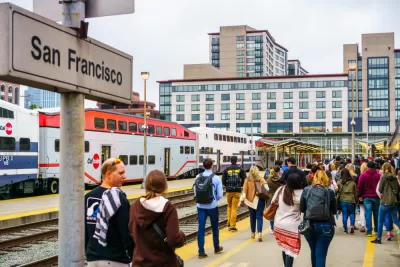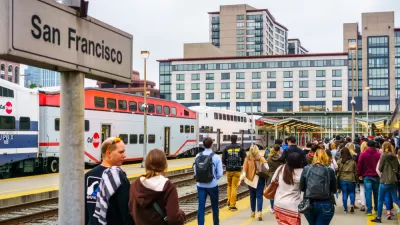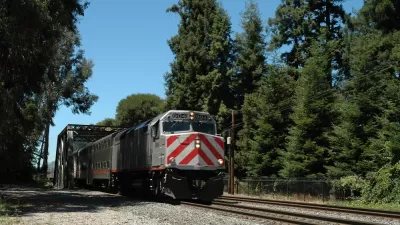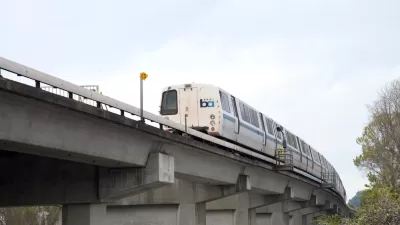A plan to integrate the various regional transit providers in the San Francisco Bay Area could be the key to winning back transit riders in the post-pandemic world.

Momentum is building for an idea that would merge Bay Area Rapid Transit (BART) with CalTrain and other regional rail providers to create a single regional rail system that would completely encircle the San Francisco Bay Area, reports Nico Savidge.
Seamless Bay Area released a report earlier this month that "recommends bringing BART, Caltrain and other longer-distance operators such as San Francisco Bay Ferry and the North Bay's Golden Gate Transit together into a single system that stretches from Santa Rosa to Gilroy," according to Savidge.
The report recommends an integrated fare system that would create a zone system for fares—charging one price even if riders transfer from one system to another within a zone.
"It's a long-debated idea, but there are signs momentum could be building," writes Savidge. "A merger with BART is one of the concepts Caltrain's board is considering this year as it overhauls the railroad's management. And COVID-19 has upped the pressure throughout the Bay Area to better coordinate service between agencies if they want to win back riders in the post-pandemic world."
Savidge provides more evidence of the growing political momentum for the idea in the source article (which is also available at Mass Transit if The Mercury News paywall is an obstacle). One key driver of the new momentum for the idea of integrated regional rail in the Bay Area is the need to entice riders back to transit in the post-pandemic world.
Meanwhile, Seamless Bay Area has launched a Kickstarter to raise the funds to create a board game called Connect the Bay to illustrate the integrated fare concept.
FULL STORY: Could a BART-Caltrain merger help fix one of Bay Area transit's biggest problems?

Manufactured Crisis: Losing the Nation’s Largest Source of Unsubsidized Affordable Housing
Manufactured housing communities have long been an affordable housing option for millions of people living in the U.S., but that affordability is disappearing rapidly. How did we get here?

Americans May Be Stuck — But Why?
Americans are moving a lot less than they once did, and that is a problem. While Yoni Applebaum, in his highly-publicized article Stuck, gets the reasons badly wrong, it's still important to ask: why are we moving so much less than before?

Research Shows More Roads = More Driving
A national study shows, once again, that increasing road supply induces additional vehicle travel, particularly over the long run.

Judge Halts Enforcement of Anti-Homeless Laws in Grants Pass
The Oregon city will be barred from enforcing two ordinances that prosecute unhoused residents until it increases capacity and accessibility at designated camping sites.

Advancing Sustainability in Los Angeles County Schools
The Los Angeles County Office of Education’s Green Schools Symposium brings together educators, students, and experts to advance sustainability in schools through innovative design, climate resilience strategies, and collaborative learning.

Using Old Oil and Gas Wells for Green Energy Storage
Penn State researchers have found that repurposing abandoned oil and gas wells for geothermal-assisted compressed-air energy storage can boost efficiency, reduce environmental risks, and support clean energy and job transitions.
Urban Design for Planners 1: Software Tools
This six-course series explores essential urban design concepts using open source software and equips planners with the tools they need to participate fully in the urban design process.
Planning for Universal Design
Learn the tools for implementing Universal Design in planning regulations.
City of Moreno Valley
Institute for Housing and Urban Development Studies (IHS)
City of Grandview
Harvard GSD Executive Education
NYU Wagner Graduate School of Public Service
City of Cambridge, Maryland
Newport County Development Council: Connect Greater Newport





























